Papers by Michelle Cameron
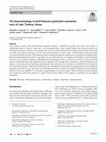
Archaeological and Anthropological Sciences, 2019
Early herders in eastern Africa built elaborate megalithic cemeteries ~ 5000 BP overlooking what ... more Early herders in eastern Africa built elaborate megalithic cemeteries ~ 5000 BP overlooking what is now Lake Turkana in northwestern Kenya. At least six 'pillar sites' were constructed during a time of rapid change: cattle, sheep, and goats were introduced to the basin as the lake was shrinking at the end of the African Humid Period. Cultural changes at this time include new lithic and ceramic technologies and the earliest monumentality in eastern Africa. Isolated human remains previously excavated from pillar sites east of Lake Turkana seemed to indicate that pillar site platforms were ossuaries for secondary burials. Recent bioarchaeological excavations at four pillar sites west of the lake have now yielded ≥49 individuals, most from primary and some from secondary interments, challenging earlier interpretations. Here we describe the mortuary cavities, and burial contexts, and included items such as adornments from Lothagam North, Lothagam West, Manemanya, and Kalokol pillar sites. In doing so, we reassess previous hypotheses regarding pillar site construction, use, and inter-site variability. We also present the first osteological analyses of skeletons buried at these sites. Although the human remains are fragmentary, they are nevertheless informative about the sex, age, and body size of the deceased and give evidence for health and disease processes. Periosteal moulds of long bone midshafts (n = 34 elements) suggest patterns of terrestrial mobility. Pillar site deposits provide important new insights into early herder lifeways in eastern Africa and the impact of the transition to pastoralism on past human populations.
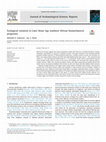
A B S T R A C T Behavioural ecology suggests that human populations modify their behaviour, inclu... more A B S T R A C T Behavioural ecology suggests that human populations modify their behaviour, including subsistence strategy, technology, and mobility, in response to ecological variation. This paper examines if cross-sectional geometric properties (CSGPs) indicative of habitual physical behaviours, including manual activities and terrestrial mobility , vary among southern African Later Stone Age (LSA) Mediterranean Cape coast (n = 85), semiarid central interior (n = 53), and hyperarid Namib Desert (n = 17) individuals. Results will be contextualised using the dietary breadth model, which accounts for the search and handling costs associated with acquiring and processing resources. CSGPs were assessed for humeri, femora, and tibiae using periosteal moulds and 3D laser surface scans at the humerus middistal (35%) location as well as the femur and tibia midshaft (50%) locations. Humerus strength indicators were higher among central interior and Namib Desert females. This may have occurred due to decreased resource quality and quantities in these semiarid and arid ecologies. Females in particular may have enhanced resource-processing efforts to maximise nutritional intake in sparse ecologies. Lower limb biomechanical properties indicative of strength were highest among Cape coast individuals, but it is not clear if search efforts were higher in this region, or if other factors like complex terrain imposed a bio-mechanical cost for individuals living in this region. Overall, local ecologies interact with subsistence strategies to impact upper limb habitual activities among LSA southern African groups.
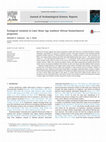
Behavioural ecology suggests that human populations modify their behaviour, including subsistence... more Behavioural ecology suggests that human populations modify their behaviour, including subsistence strategy, technology, and mobility, in response to ecological variation. This paper examines if cross-sectional geometric properties (CSGPs) indicative of habitual physical behaviours, including manual activities and terrestrial mobility , vary among southern African Later Stone Age (LSA) Mediterranean Cape coast (n = 85), semiarid central interior (n = 53), and hyperarid Namib Desert (n = 17) individuals. Results will be contextualised using the dietary breadth model, which accounts for the search and handling costs associated with acquiring and processing resources. CSGPs were assessed for humeri, femora, and tibiae using periosteal moulds and 3D laser surface scans at the humerus middistal (35%) location as well as the femur and tibia midshaft (50%) locations. Humerus strength indicators were higher among central interior and Namib Desert females. This may have occurred due to decreased resource quality and quantities in these semiarid and arid ecologies. Females in particular may have enhanced resource-processing efforts to maximise nutritional intake in sparse ecologies. Lower limb biomechanical properties indicative of strength were highest among Cape coast individuals, but it is not clear if search efforts were higher in this region, or if other factors like complex terrain imposed a bio-mechanical cost for individuals living in this region. Overall, local ecologies interact with subsistence strategies to impact upper limb habitual activities among LSA southern African groups.
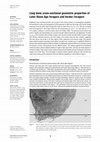
Diaphyseal cross-sectional geometry can be used to infer activity patterns in archaeological popu... more Diaphyseal cross-sectional geometry can be used to infer activity patterns in archaeological populations. We examined the cross-sectional geometric (CSG) properties of adult Later Stone Age (LSA) herder-forager long bones from the inland lower Orange River Valley of South Africa (n=5 m, 13 f). We then compared their CSG properties to LSA forager adults from the coastal fynbos (n=23 m, 14 f) and forest (n=17 m, 19 f) regions, building on a previous report . The periosteal mould method was used to quantify total subperiosteal area, torsional strength, bilateral asymmetry and diaphyseal circularity (I max /I min ) at the mid-distal (35%) location of upper arms (humeri) and the mid-shaft (50%) location of upper legs (femora). Maximum humerus and femur lengths were similar among the three samples, suggesting that adult stature was similar in all three regions. When compared to the previous study, CSG property values obtained using the periosteal mould method correlated well, and there were no significant differences between data collected using the different methods. No statistically significant differences were found among the humerus or femur CSG properties from the different regions. This finding suggests that all individuals undertook similar volitional habitual activities in regard to their upper limbs, and also had similar degrees of terrestrial mobility. These results indicate relative behavioural homogeneity among LSA foragers and herderforagers from South Africa. The small degree of regional variation apparent among the three samples may reflect local ecology and the subsistence demands affecting populations in these different regions. S29°S 33°F igure 1: Map of southern Africa with forest, fynbos and lower Orange River Valley regions approximated. The fynbos region is indicated by the solid outline, the forest region by the small dotted outline and the lower Orange River Valley by the dashed outline. Black lines indicate approximate latitude markers and the star indicates the approximate location of Koffiefontein.
Conference Presentations by Michelle Cameron
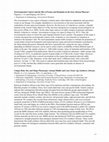
Holocene Southern African Later Stone Age (LSA) individuals and their contemporary descendants, t... more Holocene Southern African Later Stone Age (LSA) individuals and their contemporary descendants, the KhoeSan peoples of southern Africa, have small adult body sizes and gracile builds. Genetic analyses indicate that contemporary KhoeSan groups diverged from non-Khoesan groups approximately 110–160 kya during the Middle Stone Age (MSA). The most diverse group of MSA postcranial fragments comes from the Klasies River Main Site (KRM) on the southern Cape coast. The KRM materials include a lumbar vertebra, a left clavicle, a left proximal radius, a right proximal ulna, and left first metatarsal. This paper compares the external linear dimensions, shape characteristics, and cross-sectional geometric properties (CSGP) of the KRM postcrania to those of LSA southern Africans to assess if distinctive small body sizes and shapes are evident in the MSA. Discriminant function analyses (DFAs) and analyses of variance (ANOVAs) are used to compare each of the KRM elements to adult LSA southern Africans (n=108) and to other Holocene groups (n=149) that encompass a range of body sizes.
The DFAs group the KRM elements, except for the ulna, with LSA southern Africans when predicting group membership (α<0.01). The similarities between KRM and LSA southern African materials are likely driven by size. KRM clavicle and metatarsal CSGP have greater torsional and compressive strength properties than analogous elements from LSA southern Africans. These results demonstrate that small southern African adult body sizes may have great temporal depth and provide further evidence for biological continuities between MSA and LSA southern Africans, consistent with genomic studies.
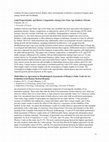
Southern African Later Stone Age (LSA) body size variability has been associated with changes in ... more Southern African Later Stone Age (LSA) body size variability has been associated with changes in population density. Dietary composition, as indicated by carbon (δ13C) and nitrogen (δ15N) stable isotopes, does not correlate with body size variability. Intrapopulation variation in LSA limb proportions (i.e. the ratios between proximal and distal limb element lengths) has received less attention. Limb proportionality is often debated in human evolutionary research as it may be affected by climate. However, limb proportions may additionally reflect environmental stressors experienced during growth and development, including nutritional insufficiency. LSA groups from the Mediterranean-type Cape coast and the semiarid central interior consumed different types of foods due to ecological and subsistence strategy variation between these regions. Differential resource availability may have impacted the growth and development of particularly distal limb segments with implications for adult limb proportions. This paper tests if dietary composition, as indicated by δ13C and δ15N stable isotopes, influenced LSA southern African limb proportions among Cape coast (n=73) and central interior (n=38) groups. Maximum humerus, radius, femur, and tibia lengths were used to calculate brachial (radius/humerus) and crural (tibia/femur) indices. Pearson correlation coefficients were used to assess the direction and strength of relationships between these indices and δ13C and δ15N ratios. Central interior crural indices correlated positively with δ15N values, indicating greater tibia lengths relative to femur lengths with the consumption of higher trophic level foods. The consumption of higher trophic level foods in the unpredictable central interior may have positively impacted growth and development in this region.
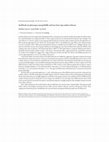
Southern African Later Stone Age (LSA) individuals and their contemporary descendants, the KhoeSa... more Southern African Later Stone Age (LSA) individuals and their contemporary descendants, the KhoeSan peoples of southern Africa, have small adult body sizes and gracile builds [1]. These unique proportions are documented from historic times through to the early Holocene [1]. Genetic analyses of contemporary KhoeSan groups in southern African indicate that they diverged from non-Khoesan groups approximately 110 – 160 kya [2]. This divergence dates to the Middle Stone Age (MSA), where skeletal remains are scarce in southern Africa. While postcranial skeletal elements are available from De Kelders Cave 1 (Klipgat), Border Cave, and Cave of Hearths, the most diverse group of MSA postcranial fragments come from the Klasies River Main Site (KRM) on the southern Cape coast near Knysna, with relatively firm dates to MIS 5 [3]. This region features a temperate Mediterranean climate. The KRM materials include a lumbar vertebra, a left clavicle, a left proximal radius, a right proximal ulna, and left first metatarsal [3]. Studies across multiple sites suggest that a range of body sizes existed in the MSA [4]. However the KRM postcrania were noted as appearing similar in size to LSA southern Africans [5].
A substantial number of southern African LSA skeletal elements are available for comparison. This paper compares the external linear dimensions, shape characteristics, and cross-sectional geometric properties (CSGP) of the KRM postcrania to those of LSA southern Africans to assess if distinctive small body sizes are evident in the MSA. This will clarify if small adult size may represent an early, presumably adaptive, trait in the KhoeSan lineage. Discriminant function analyses (DFAs) are used to compare each of the KRM elements to adult LSA southern African individuals (n=108) as well as to other Holocene groups that encompass a range of body sizes (Andaman Islanders, n=32; northeastern Native Americans, n=23; eastern African LSA groups, n=31; Iberomaurusian individuals, n=52; and Australian Aborigines, n=11). This approach differentiates individuals based on assumed and predicted group membership.
All of the DFAs are statistically significant (α < 0.01), and the dimensions of the KRM materials consistently overlap with LSA southern Africans. All DFA models group the KRM elements with LSA southern Africans when predicting group membership. The first discriminant function is highly significant in all DFAs for the groups analysed, so the similarities between KRM and LSA southern African materials are likely driven by size. Despite the similarities in size and shape, those KRM elements where CSGP can be assessed (clavicle, metatarsal) have greater torsional and compressive strength properties than analogous elements from the LSA southern Africans.
These results demonstrate that small southern African adult body sizes may have great temporal depth. This paper provides further evidence for biological continuities between MSA and LSA southern Africans, consistent with genomic studies. These comparisons extend the presence of small body sizes associated with contemporary KhoeSan peoples into the Pleistocene.
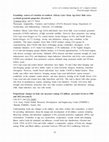
Southern African Later Stone Age (LSA) individuals have lower limb cross-sectional geometric prop... more Southern African Later Stone Age (LSA) individuals have lower limb cross-sectional geometric properties (CSGPs) indicative of high terrestrial mobility. However these properties vary among LSA Cape coast foragers (n=72), central interior herder-foragers (n=50), and Namib Desert herder-foragers (n=17). Ecology, terrain, and subsistence strategy may contribute to this variability. This paper examines lower limb CSGP variation among LSA groups by contextualizing their CSGPs with those of foraging groups (Australian Aborigines, n=29; Andaman Islanders, n=27; Santa Cruz Islanders, n=30; Sadlermiut, n=30; Yaghan foragers, n=21) and non-foraging groups (Badari herders, n=9; Kerma agriculturalists, n=28) from regions with diverse ecologies and terrains. Midshaft (50%) femoral and tibial torsional strength (J), total subperiosteal area (TA), and diaphyseal shape indicators (Imax/Imin and Ix/Iy) were compared. CSGPs were calculated from periosteal contours obtained using periosteal molds and 3D laser surface scans. LSA Cape coast and central interior individuals have higher TA and J than other foraging and non-foraging groups, but have similar values to some terrestrial foragers, including Australian Aborigines. However, Namib Desert individuals have similar CSGPs to Badari herders. These results may reflect more intensive foraging among Cape coast individuals; sparse resource availability in the semiarid central interior; and more intensive herding in the Namib Desert. LSA Cape coast men and women have high Imax/Imin and Ix/Iy. This trait is shared with other groups who lived in mountainous regions, including Santa Cruz Islanders. Overall, LSA lower limb strength and robusticity properties may vary with resource availability and subsistence strategy, while shape indicators may vary with terrain.
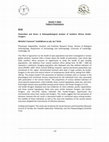
The effect of agriculture on the health of past populations has been investigated in various glob... more The effect of agriculture on the health of past populations has been investigated in various global contexts, however little is known about the health of pastoralists. Later Stone Age (LSA) southern Africa presents an opportunity to study the health of past herding populations. LSA skeletons from coastal southern Africa dating from 10 000 -2000 bp represent a prehistoric foraging population who displayed very few skeletal indicators of stress (Pfeiffer, 2007(Pfeiffer, , 2012. Around 2000 bp, however, caprine and bovine pastoralism was introduced to this region. Domesticated livestock were kept in large numbers by herderforagers in the semi-arid central interior of contemporary South Africa, dating from 2000 -200 bp. This project tested if the possession of livestock correlates with an increase in the physiological and nutritional stresses experienced by LSA individuals from sites associated with pastoralism in the central interior. The proportions of various skeletal indicators of stress (porotic hyperostosis, cribra orbitalia, linear enamel hypoplasias, body size, and intralimb length indices) were quantified among central interior LSA herder-foragers (n=112). LSA herder-foragers displayed very low incidences of cribra orbitalia, porotic hyperostosis, and linear enamel hypoplasias. Body sizes were similar between foragers and herderforagers, and intra-limb indices indicated that herder-foragers experienced less environmental stress than coastal LSA foragers. The results suggest that the possession of domestic livestock did not result in decreased health or nutritional status among herders: the mobility of these individuals as well as the semi-arid conditions of the central interior may have mitigated the transmission of infectious diseases.
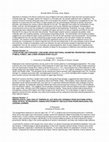
Ogoriland is situated in the Benue-confluence area of Nigeria with early settlement sites that we... more Ogoriland is situated in the Benue-confluence area of Nigeria with early settlement sites that were occupied several hundred years ago. The paper reports the research in Onumoba site, the earliest settlement site in Ogoriland. The research aimed at reconstructing past ways of life of the people who settled in Ogoriland by investigating the site. The objective is to document the oral history of Ogori people and use archaeological methods to identify, document, describe, and interpret the various cultural materials on the site. The approach that entails the combination of oral, written, archival, and ethnographic data, reconnaissance and survey methods was employed. Archaeological reconnaissance and survey was employed in acquiring data to test hypotheses. Potsherds, iron slag, tuyères and smoking pipe were collected randomly to represent the types and forms of cultural materials and finds on the site. Mounds of iron slag on the site were documented. The principal material remains analysed was pottery; other materials were iron smelting residues, smoking pipe and grinding stones. The classification and analysis of pottery suggests the use of different types of pots and bowls on the site for both domestic and ritual purposes. The synthesis of data gathered from the site was interpreted as past human activities on the site which include iron smelting activities. The research corroborated and verified the hypothesis that the site was both a settlement and an iron smelting site. A comparison of cultural materials from the site and related sites in the area indicates cultural change and continuity. Evidence of population continuum between the past and present people of Ogoriland was also established. Over all, the research in Onumoba site substantiated the claim of early settlement in Ogoriland and provides unique evidence of early human utilization of space for the purpose of settlement and industrial activities.









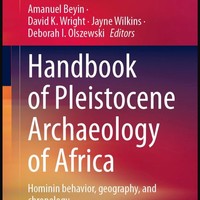
Uploads
Papers by Michelle Cameron
Conference Presentations by Michelle Cameron
The DFAs group the KRM elements, except for the ulna, with LSA southern Africans when predicting group membership (α<0.01). The similarities between KRM and LSA southern African materials are likely driven by size. KRM clavicle and metatarsal CSGP have greater torsional and compressive strength properties than analogous elements from LSA southern Africans. These results demonstrate that small southern African adult body sizes may have great temporal depth and provide further evidence for biological continuities between MSA and LSA southern Africans, consistent with genomic studies.
A substantial number of southern African LSA skeletal elements are available for comparison. This paper compares the external linear dimensions, shape characteristics, and cross-sectional geometric properties (CSGP) of the KRM postcrania to those of LSA southern Africans to assess if distinctive small body sizes are evident in the MSA. This will clarify if small adult size may represent an early, presumably adaptive, trait in the KhoeSan lineage. Discriminant function analyses (DFAs) are used to compare each of the KRM elements to adult LSA southern African individuals (n=108) as well as to other Holocene groups that encompass a range of body sizes (Andaman Islanders, n=32; northeastern Native Americans, n=23; eastern African LSA groups, n=31; Iberomaurusian individuals, n=52; and Australian Aborigines, n=11). This approach differentiates individuals based on assumed and predicted group membership.
All of the DFAs are statistically significant (α < 0.01), and the dimensions of the KRM materials consistently overlap with LSA southern Africans. All DFA models group the KRM elements with LSA southern Africans when predicting group membership. The first discriminant function is highly significant in all DFAs for the groups analysed, so the similarities between KRM and LSA southern African materials are likely driven by size. Despite the similarities in size and shape, those KRM elements where CSGP can be assessed (clavicle, metatarsal) have greater torsional and compressive strength properties than analogous elements from the LSA southern Africans.
These results demonstrate that small southern African adult body sizes may have great temporal depth. This paper provides further evidence for biological continuities between MSA and LSA southern Africans, consistent with genomic studies. These comparisons extend the presence of small body sizes associated with contemporary KhoeSan peoples into the Pleistocene.
The DFAs group the KRM elements, except for the ulna, with LSA southern Africans when predicting group membership (α<0.01). The similarities between KRM and LSA southern African materials are likely driven by size. KRM clavicle and metatarsal CSGP have greater torsional and compressive strength properties than analogous elements from LSA southern Africans. These results demonstrate that small southern African adult body sizes may have great temporal depth and provide further evidence for biological continuities between MSA and LSA southern Africans, consistent with genomic studies.
A substantial number of southern African LSA skeletal elements are available for comparison. This paper compares the external linear dimensions, shape characteristics, and cross-sectional geometric properties (CSGP) of the KRM postcrania to those of LSA southern Africans to assess if distinctive small body sizes are evident in the MSA. This will clarify if small adult size may represent an early, presumably adaptive, trait in the KhoeSan lineage. Discriminant function analyses (DFAs) are used to compare each of the KRM elements to adult LSA southern African individuals (n=108) as well as to other Holocene groups that encompass a range of body sizes (Andaman Islanders, n=32; northeastern Native Americans, n=23; eastern African LSA groups, n=31; Iberomaurusian individuals, n=52; and Australian Aborigines, n=11). This approach differentiates individuals based on assumed and predicted group membership.
All of the DFAs are statistically significant (α < 0.01), and the dimensions of the KRM materials consistently overlap with LSA southern Africans. All DFA models group the KRM elements with LSA southern Africans when predicting group membership. The first discriminant function is highly significant in all DFAs for the groups analysed, so the similarities between KRM and LSA southern African materials are likely driven by size. Despite the similarities in size and shape, those KRM elements where CSGP can be assessed (clavicle, metatarsal) have greater torsional and compressive strength properties than analogous elements from the LSA southern Africans.
These results demonstrate that small southern African adult body sizes may have great temporal depth. This paper provides further evidence for biological continuities between MSA and LSA southern Africans, consistent with genomic studies. These comparisons extend the presence of small body sizes associated with contemporary KhoeSan peoples into the Pleistocene.